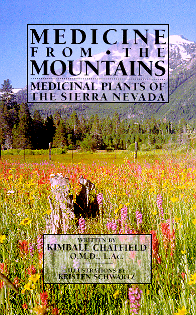

Each genus is covered in five sections. The description and habitat section allows the reader to know where to look for these valuable plants in the Sierra as well as their general description. Next is plant chemistry, often missed in other texts, detailing plant constituents giving the reader valuable information about what is responsible for the plant's medicinal actions. Next is a section on historic and modern uses. Included here is rare information gathered from exhaustive research into Native American uses of these plants. Also covered are historic uses of these plants in Europe, the Orient and other parts of the world by physicians and folk healers of the past. The latest scientific studies are brought into play giving both the casual reader and serious clinician up to date objective research information. Toxicities are given next, allowing the reader to understand the cautions needed to know in using these mountain medicines. A chapter on dosage follows giving precise measurements and the ways these plants may be prepared for optimal use. Lastly is a section on cultivation so that the reader may grow their own medicinal plants.
An informative glossary, a resource guide to nurseries and horticulture suppliers, and a very extensive bibliography and suggested reading section finish out this unique text.
Experts unanimously agree this is a landmark book.
"A treasure trove of information on medicinal plants in the Sierra. Well written and well researched, this book is a must for anyone living in or traveling to northern California and is also valuable for all students and professionals interested in medicinal herbs."
– Mark Blumenthal, Founder and Executive Director American Botanical Council; Editor, HerbalGram"A smooth reading medicinal flora for the Sierra Nevada. The author skillfully relates it to Eastern American and European plants as well. I certainly want this compact volume next time I travel to the Range of Light."
– James A. Duke, Ph.D., Economic Botanist – U.S.D.A. (Retired)"Medicine From the Mountains uniquely contrasts the current use of Sierra Nevada plants by scientists, physicians and folk healers with their historic importance. This informative work will serve as a valuable reference for those that merely want to appreciate these glorious plants as they hike this majestic mountain range, as well as for those that inspire to understand plant chemical composition and pharmaceutical value. I enthusiastically recommend this enlightening and beautifully illustrated test."
– David I. Kusher, Ph.D., Wofford College"This book really covers everything one needs to know about Sierra Nevada medicinal plants. Historic and modern uses, plant chemistry, dosages, toxicities and where to find these important mountain medicines are all detailed. It even covers how to grow them in our own yards. Medicine From the Mountains is interesting and fun to read. If you love the Sierra, you'll love this book!"
– Arnold Abrams, Ph.D., Southern Oregon University"Dr. Chatfield is a revered professor and practitioner of herbal medicine and acupuncture in the Lake Tahoe area. His classroom and field trips are filled with college students who cherish his scientific and practical herbal wisdom. Medicine From the Mountains is a fascinating guide to the healing potential of the flora of the beautiful Sierra Nevada, written by one who is obviously in love with these flower laden peaks. It will be a great addition to your backpack or herbal bookshelf."
– Richard Botto, M.D., Director of Public Health, Alpine County"Medicine From the Mountains takes us to the rugged Sierra gardens and lights a fire of appreciation and understanding. The Sierra enthusiast, botanist, hiker, and healer will all enjoy and embrace this book!"
– Dr. Kenneth Rumack, D.C., South Lake Tahoe"Medicine From the Mountains is a surprisingly good read and a good reference work."
– Bear Klaw, Sierra Club
About the Author
Kimball Chatfield is a Board Certified Acupuncturist and Doctor of Oriental Medicine. He also has
a bachelors degree from San Diego State University in Natural Resource Management. He is former professor
of Clinical Nutrition at Santa Barbara College of Oriental Medicine. Currently he teaches Botanical Medicine
and Medicinal Plants of the Sierra Nevada at Lake Tahoe Community College.
About the Illustrator
Kristen Schwartz is a Botanical Illustrator specializing in medicinal plants. She and her husband
live at Lake Tahoe and spend the summer months hiking and camping while Kristen searches for plant subjects
to photograph and sketch. She spends the rest of the year illustrating from details she collects in the summertime.
Cover photo: Melinda Chatfield
To Order Books Directly from the Publisher, Follow These Simple Steps:
Medicine From the Mountains
Name ______________________________________ _____ Books at $17.95 ea. ______
Street _______________________________________ CA Sales Tax $1.35 ea. ______
City _________________________________________ Shipping 1st Book: $3.00 ______
State __________________ Zip ________________ 2nd Book: $1.50 ______
Country ______________________________________ Each Addit'l Book: $.50 ______
TOTAL: ______
Copyright © 1995-2009 by Graphic Gold Webmasters. All rights reserved.